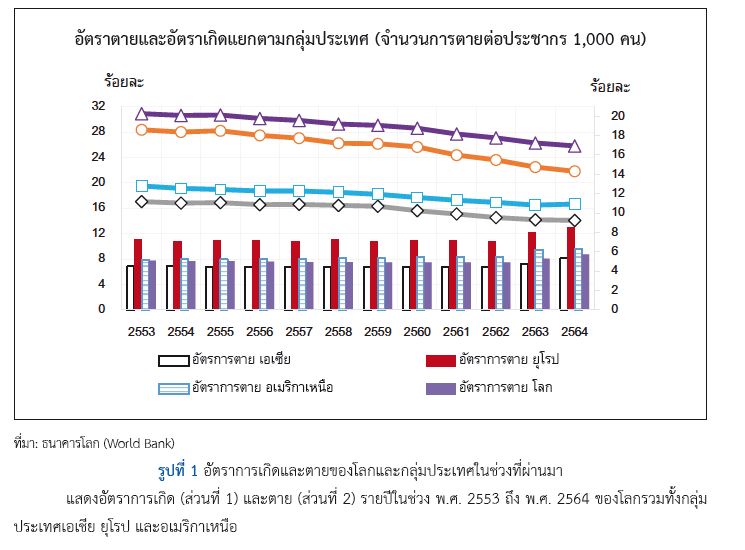การศึกษาอัตราการเกิดรายจังหวัดของไทย
คำสำคัญ:
อัตราการเกิด; ประเทศไทย; อาเซียนบทคัดย่อ
บทความนี้มีวัตถุประสงค์ 1) เพื่อเปรียบเทียบอัตราการเกิดและปัจจัยทางเศรษฐกิจสังคม รวมทั้งปัจจัยทางด้านธรรมาภิบาลระดับประเทศของไทยกับประเทศในอาเซียน 2) เพื่อวิเคราะห์ปัจจัยทางด้านเศรษฐกิจและสังคมระดับจังหวัดที่มีอิทธิพลในการกำหนดอัตราการเกิดของไทย รูปแบบการวิจัยเป็นการศึกษาเชิงประจักษ์โดยใช้ข้อมูลพาแนลระดับประเทศ 8 ประเทศในอาเซียน และข้อมูลรายจังหวัดจาก 77 จังหวัดของไทย โดยการวิเคราะห์สมการถดถอยจากข้อมูลพาแนล ผลการวิจัยพบว่าอัตราเกิดของทุกประเทศในอาเซียนมีแนวโน้มลดลงอย่างต่อเนื่องสอดคล้องกับแนวโน้มของโลก ประเทศไทยมีอัตราการเกิดที่ต่ำเป็นอันดับสองรองจากสิงคโปร์ ในขณะที่มีอัตราการตายสูงเป็นอันดับสองเช่นกัน ทำให้ไทยมีแนวโน้มที่จะประสบกับปัญหาการขาดแรงงานในอนาคตได้ หากรัฐบาลยังไม่มีนโยบายที่ชัดเจนในการจัดการกับเรื่องนี้ และการศึกษายังพบว่าธรรมาภิบาลการปกครองประเทศมีผลทางบวกกับอัตราการเกิด ทำให้เป็นข้อกังวลถึงความสามารถของรัฐในการจัดการกับปัญหานี้ เนื่องจากไทยมีธรรมาภิบาลที่ต่ำกว่าสิงคโปร์ในทุกด้าน แต่สิงคโปร์ก็ยังไม่สามารถผลักดันให้อัตราการเกิดกลับมาอยู่ในระดับเดิมได้ สำหรับปัจจัยทางเศรษฐกิจสังคมที่มีอิทธิพลกับอัตราการเกิดรายจังหวัดของไทย พบว่าปัจจัยที่มีความสัมพันธ์ทางบวกกับอัตราการเกิดคือความหนาแน่นประชากร และจำนวนโรงงานต่อประชากร ส่วนปัจจัยที่มีความสัมพันธ์ทางลบได้แก่ รายได้ต่อหัวรายจังหวัด สัดส่วนผู้สูงอายุ สัดส่วนแรงงานสตรี และอัตราการฆ่าตัวตาย ผลของการศึกษานี้ช่วยเพิ่มความเข้าใจทางด้านการเปลี่ยนแปลงประชากรในมิติที่ครอบคลุมมากขึ้น ซึ่งจะเป็นประโยชน์ต่อนโยบายการชะลอการลดลงของอัตราการเกิดที่มีผลกระทบต่อกำลังแรงงานและการพัฒนาประเทศต่อไป
References
Adelman, I. (1963). An econometric analysis of population growth. The American Economic Review, 53(3), 314–339. http://www.jstor.org/stable/1809160
Ahmed, K. J., Tan, Y., & Rudd, D. (2024). Exploring the relationship between changes in fertility and disasters: A review of the literature. Journal of Population Research, 41(1), 1-29. https://doi.org/10.1007/s12546-023-09324-9
Becker, G. S. (1960). An economic analysis of fertility. In Demographic and economic change in developed countries (National Bureau Conference Series No. 11). Princeton University Press.
Becker, G. S., & Barro, R. J. (1988). A reformulation of the economic theory of fertility. The Quarterly Journal of Economics, 103(1), 1-25. https://doi.org/10.2307/1882640
Becker, G. S. (1992). Fertility and the economy. Journal of Population Economics, 5(3), 185–201. https://doi.org/10.1007/BF00172092
Bhattacharyya, A. K. (1975). Income inequality and fertility: A comparative view. Population Studies, 29(1), 5–19. https://doi.org/10.2307/2173421
Chen, M., Atiqul, H. S. M., Ahmed, K. J., Hussain, A. H. M. B., & Quamar, A. M. N. (2021). The link between climate change, food security and fertility: The case of Bangladesh. PLOS ONE, 16(10). https://doi.org/10.1371/journal.pone.0258196
Doepke, M., Hannusch, A., Kindermann, F., & Tertilt, M. (2023). The economics of fertility: A new era. In S. Lundberg & A. Voena (Eds.), Handbook of the economics of the family (Vol. 1, Issue 1, pp. 151-254). North-Holland. https://doi.org/10.1016/bs.hefam.2023.01.003
Drakatos, C. G. (1969). The determinants of birth rate in developing countries: An econometric study of Greece. Economic Development and Cultural Change, 17(4), 596-603. https://doi.org/10.1086/450386
Easterlin, R. A., Pollak, R. A., & Wachter, M. L. (1980). Toward a more general economic model of fertility determination: Endogenous preferences and natural fertility. In Population and economic change in developing countries (pp. 81-150). National Bureau of Economic Research, Inc. University of Chicago Press.
Hajdu, T. (2024). The effect of temperature on birth rates in Europe. Population and Environment, 46(9), 1-18. https://doi.org/10.1007/s11111-024-00450-x
Haq, S. M. A., Chowdhury, M. A. F., & Ahmed, K. J., et al. (2023). Environmental quality and its impact on total fertility rate: An econometric analysis from a new perspective. BMC Public Health, 23(2397), 1-16. https://doi.org/10.1186/s12889-023-17305-z
Iwasaki, I., & Kumo, K. (2020). Determinants of regional fertility in Russia: A dynamic panel data analysis. Post-Communist Economies, 32(2), 176-214. https://doi.org/10.1080/14631377.2019.1678333
Jones, L. E., & Tertilt, M. (2008). An economic history of fertility in the U.S.: 1826-1960. In P. Rupert (Ed.), Frontiers of family economics (Vol. 1). Emerald Press.
Lal, S., Singh, R., Makun, K., Chand, N., & Khan, M. (2021). Socio-economic and demographic determinants of fertility in six selected Pacific Island countries: An empirical study. PLOS ONE, 16(9), 1-17. https://doi.org/10.1371/journal.pone.0257570
Pattarakijkusol, S., & NaRanong, A. (2021). Thailand institution factors influencing middle-income earning Generation Y's fertility intentions. Journal of Demography, 37(1), 1-25. https://doi.org/10.58837/CHULA.JDM.37.1.1
Sabermahani, A., Goudarzi, R., & Nasiri, S. (2017). Factors affecting fertility rate in Iran (Panel data 1966-2013): A survey study. Journal of Family Reproductive Health, 11(3), 138-145. https://www.ncbi.nlm.nih.gov/pmc/articles/PMC6045690/
Smuseneto, A. (2019). Determinants of childbearing among Thai-Muslim Generation Y in Thailand. Journal of Population and Social Studies, 27(4), 321–333. https://so03.tci-thaijo.org/index.php/jpss/article/view/172579
Sommer, U. (2018). Women, demography, and politics: How lower fertility rates lead to democracy. Demography, 55(2), 559-586. https://doi.org/10.1007/s13524-018-0655-x
Țarcă, V., Țarcă, E., & Luca, F.-A. (2022). The impact of the main negative socio-economic factors on female fertility. Healthcare, 10(4), 734. https://doi.org/10.3390/healthcare10040734
Weintraub, R. (1962). The birth rate and economic development: An empirical study. Econometrica, 30(4), 812-817. https://www.jstor.org/stable/1909327

Downloads
เผยแพร่แล้ว
How to Cite
ฉบับ
บท
License
Copyright (c) 2024 คณะบริหารธุรกิจ สถาบันบัณฑิตพัฒนบริหารศาสตร์

This work is licensed under a Creative Commons Attribution-NonCommercial-NoDerivatives 4.0 International License.


